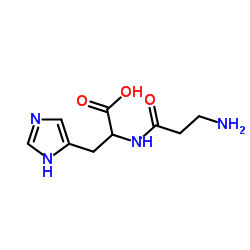Glucose 6-phosphate isomerase

Glucose 6-phosphate isomerase structure
|
Common Name | Glucose 6-phosphate isomerase | ||
|---|---|---|---|---|
| CAS Number | 9001-41-6 | Molecular Weight | 226.232 | |
| Density | 1.4±0.1 g/cm3 | Boiling Point | 656.2±55.0 °C at 760 mmHg | |
| Molecular Formula | C9H14N4O3 | Melting Point | N/A | |
| MSDS | USA | Flash Point | 350.7±31.5 °C | |
Use of Glucose 6-phosphate isomeraseGlucose 6-phosphate isomeras (GPI), i.e., phosphoglucose isomerase/phosphoglucoisomerase (PGI) or phosphohexose isomerase (PHI), is often used in biochemical studies. Glucose 6-phosphate isomeras is a highly conserved glycolytic and dimeric enzyme. Glucose 6-phosphate isomeras catalyzes the reversible isomerization of glucose-6-phosphate to fructose-6-phosphate[1]. |
| Name | carnosine |
|---|---|
| Synonym | More Synonyms |
| Description | Glucose 6-phosphate isomeras (GPI), i.e., phosphoglucose isomerase/phosphoglucoisomerase (PGI) or phosphohexose isomerase (PHI), is often used in biochemical studies. Glucose 6-phosphate isomeras is a highly conserved glycolytic and dimeric enzyme. Glucose 6-phosphate isomeras catalyzes the reversible isomerization of glucose-6-phosphate to fructose-6-phosphate[1]. |
|---|---|
| Related Catalog | |
| References |
| Density | 1.4±0.1 g/cm3 |
|---|---|
| Boiling Point | 656.2±55.0 °C at 760 mmHg |
| Molecular Formula | C9H14N4O3 |
| Molecular Weight | 226.232 |
| Flash Point | 350.7±31.5 °C |
| Exact Mass | 226.106583 |
| LogP | -2.17 |
| Appearance of Characters | lyophilized powder |
| Vapour Pressure | 0.0±2.1 mmHg at 25°C |
| Index of Refraction | 1.591 |
| Storage condition | 2-8°C |
| Personal Protective Equipment | Eyeshields;Gloves |
|---|---|
| Hazard Codes | T |
| Risk Phrases | 60-20/21/22-36/37/38-63 |
| Safety Phrases | 53-22-26-36-45 |
| RIDADR | NONH for all modes of transport |
| WGK Germany | 3 |
|
Quantitative phosphoproteomic analysis of T cell receptor signaling reveals system-wide modulation of protein-protein interactions.
Sci. Signal. 2 , ra46, (2009) Protein phosphorylation events during T cell receptor (TCR) signaling control the formation of complexes among proteins proximal to the TCR, the activation of kinase cascades, and the activation of tr... |
|
|
Initial characterization of the human central proteome.
BMC Syst. Biol. 5 , 17, (2011) On the basis of large proteomics datasets measured from seven human cell lines we consider their intersection as an approximation of the human central proteome, which is the set of proteins ubiquitous... |
|
|
The DNA sequence and biology of human chromosome 19.
Nature 428(6982) , 529-35, (2004) Chromosome 19 has the highest gene density of all human chromosomes, more than double the genome-wide average. The large clustered gene families, corresponding high G + C content, CpG islands and dens... |
| 2-[(3-Aminopropanoyl)amino]-3-(1H-imidazol-4-yl)propanoic acid |
| Histidine, β-alanyl- |
| b-Alanylhistidine |
| β-Alanylhistidine |
| carnosine |
| N-(3-Aminopropanoyl)histidine |